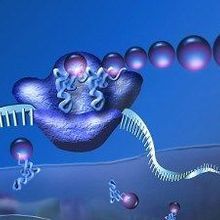Login
Subscribetranslation, cell & molecular biology, genetics & genomics

Noncoding RNA Helps Cells Recover from DNA Damage
Diana Kwon | May 1, 2017 | 2 min read
Scientists discover transcripts from the same gene that can express both proteins and noncoding RNA.

Ciliates Are Genetic-Code Deviants
Karen Zusi | Sep 30, 2016 | 1 min read
Traditional stop codons have a double meaning in the protozoans' mRNA, sometimes calling for an amino acid during translation.

Scientists Catch Translation in the Act
Ruth Williams | Sep 30, 2016 | 1 min read
Newly developed techniques from four different groups rely on the same basic steps to track translation in live cells.

Wanted: Transcriptional Regulators
Ruth Williams | Aug 1, 2016 | 2 min read
Researchers have designed a screen to find unique molecules, called riboswitches, that determine whether transcription will proceed.

AAAAA Is for Arrested Translation
Ruth Williams | Jul 24, 2015 | 3 min read
Multiple consecutive adenosine nucleotides can cause protein translation machinery to stall on messenger RNAs.

Enzyme Design
Jef Akst | Dec 3, 2014 | 2 min read
Researchers create synthetic enzymes in the lab, encoded by artificial genetic material.

Mitochondria Versus Nucleus
Juliet Ash | Feb 15, 2013 | 3 min read
Disruptions in the interaction between nuclear and mitochondrial DNA can lead to deficiencies in the mitochondrial energy-generating process, affecting fitness.
